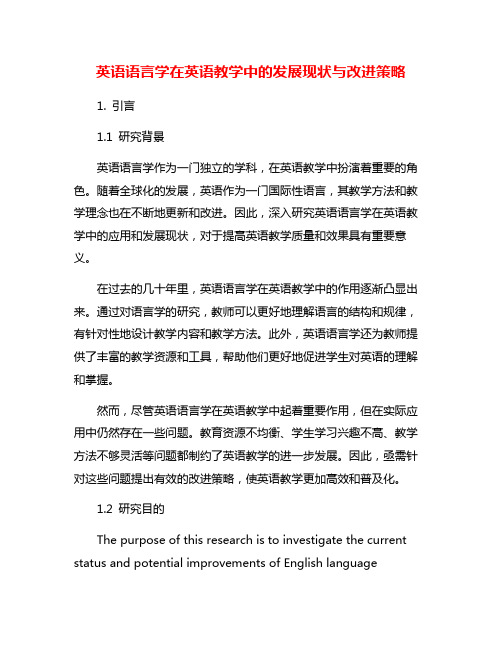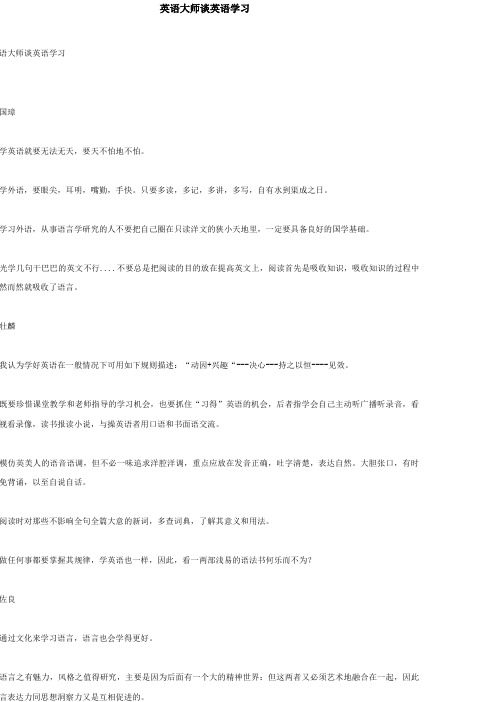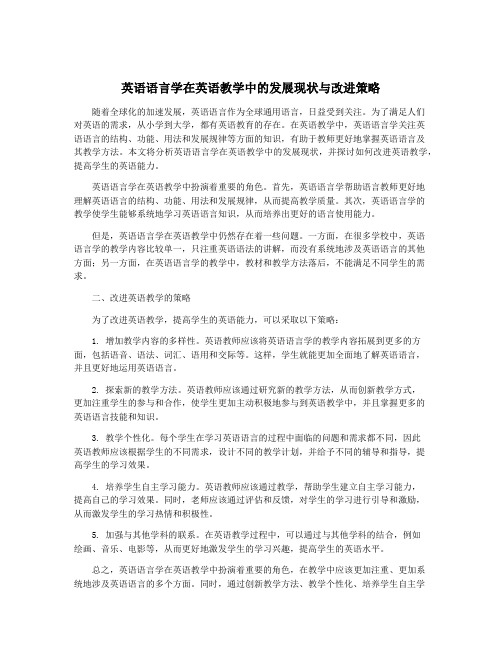一位英语语言学老前辈对英语专业发展现状的肺腑之言(转)鼎力推荐语言专业阅读
简述英语语言学及英语发展趋势概述.doc

简述英语语言学及英语发展趋势概述简述英语语言学及英语发展趋势概述导读:英语语言学及英语发展趋势概述剧的世界里,我们看到一个既现实又完全新鲜的语言。
最后,语言学的诞生和发展都是和语言教育相生相伴的,二者互相交融,共同发展。
二、英语语言学的发展(一)语言学的初期发展阶段对英语语言学的研究可以追溯到17世纪初期。
14到16世纪,欧洲历史上最伟大的运动之一文艺复兴在意大利开始,并迅速蔓延到整个欧洲,由此掀开摘要:本文通过对英语语言学及发展历史进行研究,对其发展演变有了详细了解,这有助于提高对英语语言学的全面掌握。
关键词:英语语言学;研究;交际工具1673-2596(2014)08-0206-02语言是人类最重要的交际工具,是人们进行沟通交流的各种表达符号。
人们借助语言保存和传递人类文明的成果。
从语言诞生之日起,人们对于语言的研究和探索就一直在进行着。
英语作为当今最重要的世界性语言,已经十分普及。
对于英语语言学的研究可以追溯到17世纪的初期,经过几百年的发展,英语已经是一种世界通用语言。
对英语语言的历史发展深入了解,有助于我们对英语语言学及英语发展目前状况的全面了解。
一、语言学的概念语言就广义而言,是一套共同采用的沟通符号、表达方式与处理规则,符号会以视觉、声音或者触觉方式来传递。
严格来说,语言是指人类沟通所使用的语言——自然语言。
一般人都必须通过学习才能获得语言能力,语言的目的是交流观念、意见、思想等。
语言学就是从人类研究语言分类与规则而发展出来的,是研究与所有人类语言发展有关的一门学术科目。
传统上,语言学是文化人类学的分支学科,但是现在语言学越来越独立了。
广义的语言学应该是包括每一种人类社会语言的语言学,它研究句法和词语等语言的描述,也研究语言的发展史。
每种语言都有其各自的特性,但是我们也要看到人类社会各个语种的语言学都具有其共性,即语言的交际性和社会性。
所以,在我们研究任何一种语言科学时,都要先明确几个关键因素。
他人对英语专业的看法作文

英语专业作为高等教育的一个重要分支,长期以来一直是许多学生和家长关注的焦点。
人们对英语专业的评价褒贬不一,其中不乏一些误解和偏见。
作为一名英语专业的毕业生,我希望通过我的个人经历和观察,为大家提供一个更全面、更深入的视角。
首先,许多人认为英语专业是一个万金油专业,似乎学了英语就能在任何领域找到工作。
这种看法忽略了英语专业的专业性和深度。
英语专业不仅仅是学习语言本身,更重要的是通过语言学习文化、历史、文学等多个领域的知识。
例如,在学习英美文学时,我们不仅要阅读经典作品,还要分析作者的写作手法、主题思想等,这需要深厚的文学素养和批判性思维能力。
其次,有些人认为英语专业的就业前景不好,因为人人都会英语。
这种观点过于简化了问题。
虽然现在英语普及率很高,但真正能够达到专业水平的人并不多。
英语专业的毕业生在翻译、教育、外企等领域有着广阔的发展空间。
以我自己为例,毕业后我进入了一家跨国公司工作,我的英语能力和专业知识让我在工作中游刃有余,得到了领导和同事的认可。
此外,英语专业也常常被误解为轻松的专业。
实际上,英语专业的学习同样需要付出大量的努力和时间。
我们需要阅读大量的英文文献,进行深入的思考和讨论,完成各种写作任务。
这些都不是一朝一夕能够完成的。
而且,英语专业的学生还需要具备跨文化交际的能力,这需要我们在语言学习之外,不断拓宽视野,了解不同文化背景下的思维方式和行为习惯。
当然,英语专业也面临着一些挑战。
随着科技的发展,机器翻译等技术越来越成熟,这对英语专业的学生提出了更高的要求。
我们需要不断提升自己的专业能力,不仅要精通语言,还要具备跨学科的知识储备和创新思维。
同时,我们也要关注行业动态,了解市场需求,为自己的职业发展做好规划。
总的来说,英语专业是一个充满挑战和机遇的专业。
它不仅能够培养我们的语言表达能力,还能够拓宽我们的视野,提高我们的思维能力。
虽然社会上对英语专业有一些误解和偏见,但我相信,只要我们努力学习,不断提升自己,英语专业的毕业生一定能够在各个领域发光发热,实现自己的价值。
英语语言学在英语教学中的发展现状与改进策略

英语语言学在英语教学中的发展现状与改进策略1. 引言1.1 研究背景英语语言学作为一门独立的学科,在英语教学中扮演着重要的角色。
随着全球化的发展,英语作为一门国际性语言,其教学方法和教学理念也在不断地更新和改进。
因此,深入研究英语语言学在英语教学中的应用和发展现状,对于提高英语教学质量和效果具有重要意义。
在过去的几十年里,英语语言学在英语教学中的作用逐渐凸显出来。
通过对语言学的研究,教师可以更好地理解语言的结构和规律,有针对性地设计教学内容和教学方法。
此外,英语语言学还为教师提供了丰富的教学资源和工具,帮助他们更好地促进学生对英语的理解和掌握。
然而,尽管英语语言学在英语教学中起着重要作用,但在实际应用中仍然存在一些问题。
教育资源不均衡、学生学习兴趣不高、教学方法不够灵活等问题都制约了英语教学的进一步发展。
因此,亟需针对这些问题提出有效的改进策略,使英语教学更加高效和普及化。
1.2 研究目的The purpose of this research is to investigate the current status and potential improvements of English languagelinguistics in English language teaching. Through this study, we aim to identify the role of English language linguistics in enhancing language learning and teaching strategies. By examining the development of English language linguistics in the field of English education, we seek to understand the existing challenges and explore effective strategies for improvement. This research aims to contribute to the advancement of English language teaching by providing insights into the application of linguistic theories and methodologies in language education. Additionally, we hope to offer practical suggestions for educators and policymakers to enhance the quality of English language instruction in both formal and informal settings. Ultimately, this research aims to bridge the gap between theory and practice in English language teaching, leading to more effective and engaging language learning experiences for students.1.3 研究意义Furthermore, research in this area can also contribute to the professional development of English language teachers. By staying informed about the latest developments in linguistic theories and teaching methodologies, teachers can continuously improve their skills and stay relevant in an ever-evolving field.2. 正文2.1 英语语言学在英语教学中的作用英语语言学在英语教学中的作用是十分重要的。
英语大师谈英语学习

英语大师谈英语学习语大师谈英语学习国璋学英语就要无法无天,要天不怕地不怕。
学外语,要眼尖,耳明,嘴勤,手快。
只要多读,多记,多讲,多写,自有水到渠成之日。
学习外语,从事语言学研究的人不要把自己圈在只读洋文的狭小天地里,一定要具备良好的国学基础。
光学几句干巴巴的英文不行....不要总是把阅读的目的放在提高英文上,阅读首先是吸收知识,吸收知识的过程中然而然就吸收了语言。
壮麟我认为学好英语在一般情况下可用如下规则描述:“动因+兴趣“---决心---持之以恒----见效。
既要珍惜课堂教学和老师指导的学习机会,也要抓住“习得”英语的机会,后者指学会自己主动听广播听录音,看视看录像,读书报读小说,与操英语者用口语和书面语交流。
模仿英美人的语音语调,但不必一味追求洋腔洋调,重点应放在发音正确,吐字清楚,表达自然。
大胆张口,有时免背诵,以至自说自话。
阅读时对那些不影响全句全篇大意的新词,多查词典,了解其意义和用法。
做任何事都要掌握其规律,学英语也一样,因此,看一两部浅易的语法书何乐而不为?佐良通过文化来学习语言,语言也会学得更好。
语言之有魅力,风格之值得研究,主要是因为后面有一个大的精神世界:但这两者又必须艺术地融合在一起,因此言表达力同思想洞察力又是互相促进的。
,而英语解释不但更加准确,而且通过看英语解释还能复习常用词汇和表达法,可谓“一箭双雕”。
琳在没有语言环境的情况下,外语是不可能“习得”的(但作为一种教学手段,必须尽量创造习得环境),只能“学”。
必须下艰苦的功夫。
我一向主张要“背”。
不仅儿童,成人更加要背。
且看郑板桥在《自叙》中所说:“人咸板桥读书善记,不只非善记,乃善诵耳。
板桥每读一书,必千万遍。
舟中,马上,被底,或当食忘匕著,或对客不其语,并自忘其所语,皆记书默诵也。
书有弗记者乎?”一代大师尚且如此,何况我辈凡人,更何况他背的大概不外语。
一般学习外语的,都知道有所谓“精读”和“泛读”。
殊不知,在听、说和写这其他三“会”上,也都要作精和泛工作。
英语语言学在英语教学中的发展现状与改进策略

英语语言学在英语教学中的发展现状与改进策略1. 引言1.1 背景介绍The background of English language learning and teaching is rooted in the history of colonial expansion and globalization. English has become the lingua franca of international communication, commerce, and diplomacy, leading to its widespread adoption as a second language by non-native speakers. As a result, the demand for English language education has grown exponentially over the past few decades.1.2 研究意义The significance of research in the field of English language linguistics lies in its crucial role in shaping and guiding English language teaching practices. By studying how language works, language researchers can provide valuable insights into how language learners can best acquire and use English in real-world contexts. Additionally, research in English language linguistics helps to identify and address the challenges and barriers that English language learners may encounter during the learning process.2. 正文2.1 英语语言学在英语教学中的应用英语语言学在英语教学中的应用是指将语言学理论与教学实践相结合,以提高学生的英语语言能力和沟通能力。
英语语言学在英语教学中的发展现状与改进策略

英语语言学在英语教学中的发展现状与改进策略随着全球化的加速发展,英语语言作为全球通用语言,日益受到关注。
为了满足人们对英语的需求,从小学到大学,都有英语教育的存在。
在英语教学中,英语语言学关注英语语言的结构、功能、用法和发展规律等方面的知识,有助于教师更好地掌握英语语言及其教学方法。
本文将分析英语语言学在英语教学中的发展现状,并探讨如何改进英语教学,提高学生的英语能力。
英语语言学在英语教学中扮演着重要的角色。
首先,英语语言学帮助语言教师更好地理解英语语言的结构、功能、用法和发展规律,从而提高教学质量。
其次,英语语言学的教学使学生能够系统地学习英语语言知识,从而培养出更好的语言使用能力。
但是,英语语言学在英语教学中仍然存在着一些问题。
一方面,在很多学校中,英语语言学的教学内容比较单一,只注重英语语法的讲解,而没有系统地涉及英语语言的其他方面;另一方面,在英语语言学的教学中,教材和教学方法落后,不能满足不同学生的需求。
二、改进英语教学的策略为了改进英语教学,提高学生的英语能力,可以采取以下策略:1. 增加教学内容的多样性。
英语教师应该将英语语言学的教学内容拓展到更多的方面,包括语音、语法、词汇、语用和交际等。
这样,学生就能更加全面地了解英语语言,并且更好地运用英语语言。
2. 探索新的教学方法。
英语教师应该通过研究新的教学方法,从而创新教学方式,更加注重学生的参与和合作,使学生更加主动积极地参与到英语教学中,并且掌握更多的英语语言技能和知识。
3. 教学个性化。
每个学生在学习英语语言的过程中面临的问题和需求都不同,因此英语教师应该根据学生的不同需求,设计不同的教学计划,并给予不同的辅导和指导,提高学生的学习效果。
4. 培养学生自主学习能力。
英语教师应该通过教学,帮助学生建立自主学习能力,提高自己的学习效果。
同时,老师应该通过评估和反馈,对学生的学习进行引导和激励,从而激发学生的学习热情和积极性。
5. 加强与其他学科的联系。
英语名家谈英语学习(word 文档)

英语名家谈英语学习⏹学英语就要无法无天,要天不怕地不怕。
学外语,要眼尖,耳明,嘴勤,手快。
只要多读,多记,多讲,多写,自有水到渠成之日。
许国璋教授(北外)⏹我认为学好英语在一般情况下可用如下规则描述:“动因+兴趣”--决心-持之以恒-见效。
胡壮麟教授(北大)⏹既要珍惜课堂教学和老师指导的学习机会,也要抓住“习得”英语的机会,后者指学会自己主动听广播听录音,看电视看录像,读书报读小说,与操英语者用口语和书面语交流。
模仿英美人的语音语调,但不必一味追求洋腔洋调,重点应放在发音正确,吐字清楚,表达自然。
大胆张口,有时不免背诵,以至自说自话。
阅读时对那些影响全句全篇大意的新词,多查词典,了解其意义和用法。
做任何事都要掌握其规律,学英语也一样,因此,看一两部浅易的语法书何乐而不为。
胡壮麟教授(北大)⏹要学好英语,就要对语言本身及语言所传达的各种文化信息感兴趣。
当你读到或听到别人用简洁的英语表达深奥的思想时,兴奋不已,立即记住,这就表明你已对语言产生了兴趣。
没有这种兴趣,难以在语言学习中登堂入室。
学习英语从一开始就要重视语音,语调。
发音,语调,重音,停顿,不求完美,但要基本正确。
否则,将影响听力及口语,从而使语言失去交流的功能。
⏹简易读物对打好基础极为有用,要多读。
一是数量要多,至少读四十本。
二是要重复读,选出十至十五本,读三遍,读到许多问题印在脑子中。
设想一下,别人能用一千五百到两千词汇写出几十本书来,如果我们能把这些表达方式掌握住,能够表达多少内容!在基础阶段后期,或高年级,要努力背诵名篇,比如说,背50-100篇。
无论从语言还是内容来说,这都是精华。
背熟了,对了解西方文化,对研究文字的运用都有好处。
梅仁毅教授(北外) ⏹学习外语和学习任何知识一样,是不能投机取巧的。
首先要有刻苦的精神和持之以恒的决心。
语言是有声的,因此一开始就要把语音的基础打好。
发音正确,别人才能听懂你的话,同时也便于你通过“听”来学习新的知识。
英语语言学在英语教学中的发展现状与改进策略

英语语言学在英语教学中的发展现状与改进策略概要随着全球化的发展,英语已成为世界上最重要的国际语言之一,其教学水平也成为各国教育领域的重要关注点。
英语语言学作为英语教学的理论基础,对英语教学的发展和改进起着关键作用。
本文将从英语语言学在英语教学中的现状入手,探讨其发展和改进的策略。
1.1 传统教学模式过去的英语教学主要采用传统的语法-翻译教学模式,强调学生对语法知识的掌握和对文本的翻译能力。
这种教学模式以语法为主,学生在学习过程中缺乏实际运用语言的机会,导致了语言能力的欠缺和应用能力的下降。
近年来,随着交际教学理论的兴起,许多英语教学采用了交际教学模式。
这种教学模式以交际能力为核心,注重学生的语言运用能力和沟通能力。
交际教学模式将语言学习与实际语言运用相结合,使学生更加灵活地运用所学知识。
1.3 多媒体技术的应用随着信息技术的发展,多媒体技术在英语教学中的应用日益普及。
多媒体技术能够丰富教学内容,提高学生的学习兴趣和学习效果,提升教学效率。
1.4 课程设置和教学资源英语教学的课程设置和教学资源也得到了不断完善。
教学资源的多样性和课程设置的科学性有助于提高学生的综合语言能力和语言素养。
1.5 评估体系改革传统的英语教学评估更多地侧重于语法知识和翻译能力,忽视了学生的实际应用能力和综合能力。
近年来,英语教学评估体系也进入了改革调整的过程,更加关注学生的综合语言能力和实际应用能力。
二、英语语言学在英语教学中的发展2.1 语言学习理论随着语言学习理论的不断完善,越来越多的学者开始关注语言学习的本质和规律。
如认知语言学理论、社会语言学理论、情感语言学理论等,这些理论的出现为英语教学提供了更加完善的理论支持。
2.2 语言教学方法传统的语法-翻译教学方法已逐渐淡出历史舞台,各种先进的语言教学方法如交际教学法、任务教学法、情景教学法等不断涌现。
这些新的教学方法更加关注学生的学习兴趣和学习动机,注重学生的语言实际运用能力。
- 1、下载文档前请自行甄别文档内容的完整性,平台不提供额外的编辑、内容补充、找答案等附加服务。
- 2、"仅部分预览"的文档,不可在线预览部分如存在完整性等问题,可反馈申请退款(可完整预览的文档不适用该条件!)。
- 3、如文档侵犯您的权益,请联系客服反馈,我们会尽快为您处理(人工客服工作时间:9:00-18:30)。
一位英语语言学老前辈对英语专业发展现状的肺腑之言(转)----鼎力推荐语言专业阅读缘起上世纪80年代初,我注意到,英语语言文学专业(以下简称英语专业)大多数本科生使用英语没有把握,具体表现是用不成句:读不成句,听不成句,说不成句,写不成句,译不成句。
究其原因,宏观而论,随着英语教学新思潮东渐,这些学生没有受到文革前的那种严格的基本功训练。
英语专业属应用型短线专业,学生获得读、听、说、写、译的专业技能是头等重要的事;而掌握任何一门专业技能,都需首先经过相当一段时间的严格的基本功训练,以求做到基本概念清楚、操作行为规范、各项技术熟练。
具体而言,学生读、听、说、写、译不能成句的首要原因就在于他们没有清晰、明确的英语句子概念,不知道英语句子该是个什么样,既不可缺少什么,也不可多出什么。
到了上世纪80年代中期,我又发现,英语专业大多数研究生犯有同样的毛病。
根据我近三年来通过参加入学考试成绩评估、讲授专业课程、指导撰写学位论文和参加学位论文答辩等活动对210名研究生进行的跟踪调查证实,百分之八十以上的研究生也是使用英语不能成句,百分之五十以上的研究生读不懂英语文学和学术原著,学位论文中只要是自己动笔写的部分,语言错误百孔千疮,惨不忍睹,论文答辩中的的表现更是令人尴尬。
学生在论文和答辩中的语言错误同时也反映了某些指导教师的英语水平低下、工作态度恶劣:看不出错,改不了错,甚至压根就不指导、不审读;这第三种做法,近来也很流行。
恕我直言:现在英语专业本、硕、博三个层次学生的英语状况无明显辈分差别,八成以上英语口、笔语实践能力还不及文革前名牌院系英语专业二年级学生的中下等水平;本、硕、博三个层次教授的英语状况,也是五人当中难得有一人合格;另外值得一提的是,在硕、博两个层次上都有学生的英语应用能力和专业学术水平明显超过各自硕导和博导的倒挂现象。
客气一点说,现在英语专业教授和博导的水平及能力,离文革前名牌院系英语专业的普通讲师还差一大截。
人们不禁要问:在这“六世同堂”的环境中,教授们拿什么来“教”?硕导和博导们又拿什么来“导”?今年年初,某英语期刊编辑部与我约稿,赠我两期样本,我有机会读到刊登在封面印有新闻出版总署和教育部共同认定的一份“优秀期刊免检期刊”开卷“学者论坛”专栏里某教授撰写的一篇题为“怎样学会正确使用英语”的文章。
文章在批评“PLEASE SA VING ON IT.(请节约用水。
)”这条标语的语言错误以后,下了这么个指导性结论:“save一般用于[应为‘用作’]及物动词,后面不能加on,用于[应为‘用作’]不及物动词,一般也只与for连用……。
”说得这么肯定,果真是如此吗?教授一知半解、误人子弟,由此可见一斑。
另外,学生普遍反映,听某些教授、硕导和博导用支离破碎的英语讲课,简直是活受罪,要么听不懂,要么终于听懂了也觉没有用。
说实在的,现在某些英语专业的硕点、博点,有名无实,充其量也就是本校英语教师的“镀金”车间;对外,说它们是“点”,倒不如说它们是“店”——学(位)店,金玉其外,败絮其中,“博店”尤黑。
眼下英语专业的某些博导,只会在所谓的“核心期刊”上发表连自己也读不懂的文章,对英语本身却不甚了了,别说对英语的来龙去脉一窍不通,即便在有关现代英语语音、语法和用法等常识性问题面前不是一拨即倒,就是不拨自倒,其英语听说写读译的实践能力则更属可怜、可悲;其中个别成员素质低劣,顶着五颜六色的桂冠招到处招摇撞骗,同时又到处丢人现眼,经济效益可观,贻误后学可诛。
有人把这类博导比作“进口化肥催生的无根绿豆芽”,倒也是说到了实处。
上行下效,为了有个学位,眼下考硕、考博都考疯了。
“疯考”源自“滥招”,“滥招”必然导致“滥造”——粗制滥造,现在是成批地粗制滥造,与社会上层出不穷的伪劣物质产品同出一辙,归根结底都是受“利”的驱动。
这就难怪许多在读的硕研、博研,谈起读研,苦不堪言:近八成学生对课程和教学不满意,理由是没有学到什么有用东西,恨自己投错门、认错人,捶胸跺脚,后悔莫及。
试想:专业课中外国语言学喧宾夺主,英语成了陪衬;英—汉双语翻译只讲所谓“译学”,根本不用英语;英美文学研究可借汉译本进行,对英语的要求可好可孬、可有可无——这还叫“英语语言文学专业”?近几年,英语专业又从外国语言学化和理论语言学化发展成更加不可思议的完全撇开英语的汉语化和完全脱离实际的空头学术化。
现在,英语专业的一些当红学者以研究汉语为时髦,争相用汉语在外语学科的“核心期刊”上发表研究汉语的文章或用汉语给英语专业的硕、博研究生们作研究汉语的“学术报告”,比如:汉语“自己”的研究,汉语“被”字的研究,汉语“把”字的研究,汉语“有”字的研究,汉语“都”字的研究,等等,等等,不一而足。
英语专业内部这股“非英语化”或“汉语化”的邪风似有愈刮愈烈之势。
在如此荒唐透顶的教学体制里,学生怎能指望提高自己的英语水平?又怎能指望学到什么有用东西?及至毕业,肚子里胀满了一堆常年捣腾来捣腾去、永远也派不上正用的发了酵的废物“理论”,英语却被荒疏了,不敢张口,不敢动笔,张口动笔就错,从而失去了本该属于自己的唯一具有竞争力的实用专业技术强项,以致求职时底气不足、腰杆不硬,即使想在高校谋求一个大学英语教学职位,也往往“一试即溃”。
现在的英语教育,特别是英语专业高层次的英语教育,脱离实际、玩假大空,自欺欺人竟至于此,实在令人发指。
总而言之,这几年我亲眼目睹了自我从事英语专业以来最令人尴尬、最让人痛心、同时也是最不可容忍的丑恶现象:英语专业的人,偏偏英语很糟,头衔越高,显得越糟,且一年比一年糟。
给人的感觉是:英语专业,不务正业;英语教学,名存实亡。
这究竟是怎么回事?这些事本身难道还不足以说明我们应该做些什么吗?评析这些问题的发生和发展有一个过程。
未能及时发现并解决这些问题,有四个原因。
一是到了80年代中期,文革以来积存的学子精英陆续毕业以后方显出后来者的差距。
二是人们想当然地认为,英语专业研究生,英语肯定没有问题,这给他们的英语状况不佳挡上了一层厚厚的遮布,不是有心人不易发现。
三是现在的高校,几乎一律以论文数量及发表论文的刊物档次为硬指标评聘职称,以致真才实干的渊博之士逐年减少、不学无术的浅薄之士与日俱增;英语专业就有不少南郭先生式的教授、硕导和博导,其业务强项不在英语语言文学本身和原创性研究,而在学术欺诈:文章明抄暗剽、讲课糊弄学生;为保既得利益,他们不愿也不敢正视以上那些问题,即使有人指出来,言之有据也无济于事。
四是从上个世纪90年代中期开始,又一代新人走上院系级领导岗位,其中个别佼佼者只认名、权、利,且一个也不能少,每天24小时连做梦都在“琢磨”着如何把一切高级名衔都安到自己头上,把一切大小权力都攥在自己手中,最终把一切远近实利都掠进自己口袋,重中之重是个“权”字,即由官职带来的权力;彼等深知有权的幸福、无权的痛苦和有了权就有了一切这个硬道理,视权力,即官职,为命根子,看得比性命还要紧,抓得牢牢的,死也不撒手;至于教学质量,他会反问:“现在还有谁考虑教学质量?”,全然不顾“高校毕竟是培养人才的场所,教学质量应该是教育永恒的主题”。
这后两个原因,特别是最后这个原因,是学生英语状况长期得不到改观的根本原因;加之这几年来上上下下的既得利益者又别有用心地夸大英语专业研究生“学理论、搞科研、写文章”的重要性,这无异于雪上加霜、伤口搓盐。
不错,研究生,顾名思义,就是要研究理论、从事科研和撰写论文。
但外语专业研究生有一个任何其他专业研究生不可比的实情,即必须首先解决好外语问题才能顾及其他,顾及其他也才会有建设性的意义。
以英语专业研究生为例,英语不过关,读、听、说、写、译都不能成句,甚至连英语文学原著和学术原著也读不懂,还学什么理论?搞什么科研?写什么文章?那岂不只能是生吞活剥、剽窃+拼凑,自欺欺人而已?现在的英语专业,自上而下剽窃成风、争相以文字垃圾骗取名、权、利,甚至还有教授、硕导、博导私下或公开教唆学生抄袭、剽窃的。
这些都是“学理论、搞科研、写文章”误导的结果,情节之恶劣,流毒之深广,可谓触目惊心。
事实证明,英语差,干什么实事都不行;在这一点上,没有师生之别,只有上行下效。
从道理上讲,入学新生英语差,就应当实事求是地首先,比如在第一学期,着力给他们补好英语这一课(这是专业基础之基础),其他暂且免谈或少谈;师生都应放下架子,借此机会共同把各自的英语知识和技能认真清理一遍,提高一步,并在以后的教与学中把不断提高自己英语应用水平当作头等大事常抓不懈。
这样,无论是强调还是实践“学理论、搞科研、写文章”就都不再是欺人之谈:教师英语好,不仅能给学生做出榜样,而且说话有号召力;学生英语好,干什么都有信心,干什么都行。
否则,英语专业培养研究生,在消耗了人力、物力和财力资源、最终让我们师生们脸红之余,推向社会的只是一些粗通英语、连用英语办实事的能力也不具备的空头“高级人才”。
但我坚信,随着英语专业招收研究生人数逐年上升、入学英语水平逐年下降,随着研究生们毕业时把自己的那么一点英语行为能力“研究”殆尽,随着英语专业毕业研究生就业形势日趋严峻,以上这些再简单不过的道理必将逼着决策者们认识到:得多少奖和写多少论文,既不该是科学工作的目标,更不该是教学工作的目标。
这里提出了一个原来很清楚、现在却需要澄清的问题,即本属技能—应用型的短线专业英语专业应如何给自己定位、定向?在我国,无论是在一所综合型还是研究型的大学里,英语专业的应用型属性并不因为教育层次的改变而改变。
即使在硕士生阶段,英语专业也还是要培养技术型而不是学术型的人才。
但现在的导向确是研究生阶段一律培养“理论—研究型”人才。
这里,我有两个“不相信”:第一,我不相信中国的改革和发展需要那么多的英语专业“理论—研究型”人才;第二,我不相信许多连本科生都教不好的英语专业,其硕点和博点真能培养出“理论—研究型”人才来。
如此导向,双重不切实际:既无必要,也无可能。
况且,大家都去“学理论、搞科研、写文章”,也就是说,大家都玩假、大、空,谁来办实事?谁还会想到办实事?谁还有能力办实事?道理人人都懂,有人就是装不懂,利用决策者的失误,变本加厉地误导舆论、误导青年,煞有介事地强调“理论水平”、“科研成果”和“在核心期刊上发表文章”的重要性,听似高论,实属扯淡,以为别人不懂:这只不过是掩人耳目、为学术欺诈和学术泡沫配上冠冕堂皇的标签而已。
这多年来的事实不正是如此吗?逆流下面摘录的,是英语专业某些有代表性的教授、硕导和博导等以“大师”的口气在公开场合对同行和学生们发表的训示,足以反映这多年来英语专业到底发生了一些什么事:——你们年轻人[指研究生]看一个教师的水平,不能光看他英语好、教学好这些表面现象。
教师水平主要看他的科研成果,看他在“核心期刊”上发表文章的数量。
